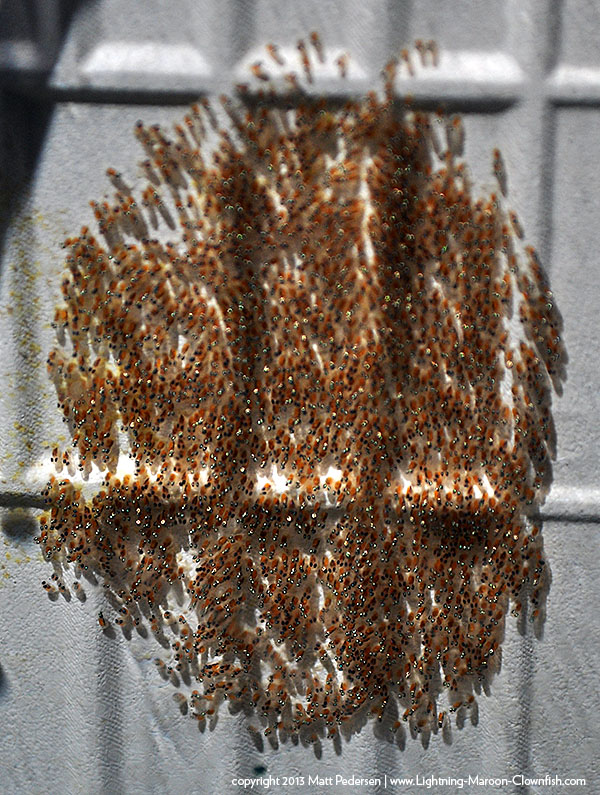I have photos of this spawn stashed away in the camera, but I figured I better get this on the books before I completely forget. Spawn #19 was put down on 12-14. With tons of stuff going on with the holidays, I did a boneheaded thing and pulled the nest on the night of the 19th going into the 20th (because I looked at my phone after Midnight, didn’t realize it was that late, saw the 20th, and said “shoot I gotta pull this tonight!”).
So the eggs went into a clean tank with all new water after a 15 minute bath on hydrogen peroxide. It was at least 24 hours early, and yet despite that, I had a handful of offspring the next morning…that’s technically 5 days after spawning! A few more offspring hatched out the subsequent night (which would have been 6 days later), and yet after that, the nest died. There has been plenty of RotiGreen Omega and rotifers in the 10 gallon blacked out tank, but by the time I departed for our holidays away, there were maybe only 3 babies I could see alive. Upon returning the day after Xmas (12-26), I could find only one baby in the tank, and by the 27th I could no longer find any larvae. Pulling my hair out.
There is one thing I’m looking at right now – I haven’t had access to wooden airstones for incubation in ages, and Joe Lichtenbert swore by them for direct egg aeration during hatching. I’ve been having all sorts of nest deaths in the Lightning Maroons when putting coarse air directly on them, so I’ve generally tried to get good ambient flow, which works better but not consistently. Well, if it’s my damn airstones I’m going to be really ticked, but my plans are to have wooden airstones on hand very soon, going out of my way to obtain them since most online suppliers have long since dropped them from their offerings.
And yet, I’ll get another shot at it still. I discovered the latest nest, Spawn #20, when checking out my tanks when I returned home from the holidays. I cannot say for certain, but given that the Lightning Maroon’s ovipositor was still down, I believe that Spawn #20 was laid on 12-26-2013. Based on that timing, the nest was pulled on the evening of 1-1-2014, going into the morning of 1/2/2014. Once again the 10 gallon tank was drained, cleaned, rinsed with freshwater, and set up. This time I used 50% new water, 40% broodstock water, and 5% RODI water to bring the specific gravity down slightly. I did not sanitize the eggs prior to pulling. There was very little orange left in the larvae, which I believe bodes well for my pull occuring at the right time to maximize whatever hatch I get. A small LED flashlight was set up at the far end of the tank to draw hatched larvae away from the heavy aeration – wooden airstones have yet to arrive, so once again I’m pummeling the eggs with coarser bubbles from a glass airstone.
You may recall the “other” pair of wild (F0) White Stripe Maroons I’ve had set up from PNG. I’ve had the pair a long time..they were paired before the Lightning Maroon ever got around to it. By my records, they put down their first spawn on 12-20-2013. Upon returning home today, I checked their nest; just a few unhatched eggs remained, which means that they hatched even FASTER than the Lightning Maroon. I would have had to pull them the late evening of 12-25….just over 5 days post spawn. The other possibility is that the parents ate most of the eggs prematurely, so I’ll have to watch the pair another few times through before I see what their pattern is. But seriously…as little as 120 hours from spawn to hatch?!
I will absolutely raise a batch from this other pair this year, and the reasoning is simple. First, we’ll want to see if by some odd chance they throw out Lightning ( I don’t believe for a second they will). Next, we’ll want to see how many show up with horns and spots and other aberrant, but not “Lightning”, markings. Ultimately, regardless of what we get, this new and completely unrelated line of F1 PNG maroons will be the IDEAL outcross for the F1 Lightning offspring. Instead of the F1 generation of PNG Maroon Clownfish stemming from only 2 foundation fish (which is really not enough), we’ll double the foundation population to 4 fish. According to FAO documentation on conservation breeding of fishes in captivity, this is still too small of a genetic bottleneck, but since I am aware of a couple other breeders who have Lightning Maroons and claim to have unrelated F0 White Stripes to mate them with, we could realistically be on very solid footing for the long term captive viability of the PNG provenance lineage of Maroon Clownfish even if we have no further access to PNG fish for months, years, decades….

Recent Comments